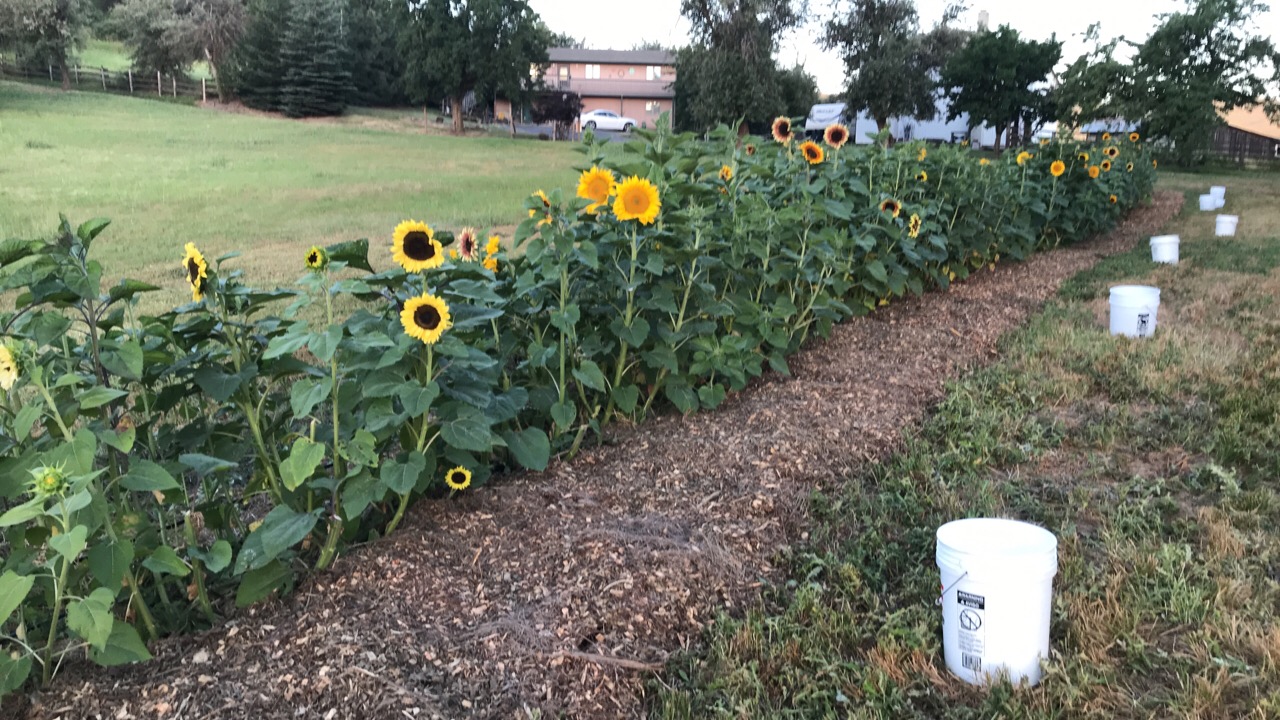About a hundred years ago, the farm that we bought had an orchard and the apples that were grown in that orchard were taken to a vinegar plant in downtown Moscow. Here is a picture of the Vinegar plant in the mid 1920s. It was torn down in the 1950’s…
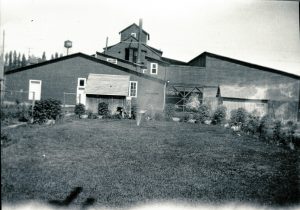
Most of the apples on the property are a variety called Ben Davis. Here is some information about Ben Davis apples taken from Wikipedia:
“During the 19th century and early 20th century it was a popular commercial apple due to the ruggedness and keeping qualities of the fruit. As packing and transportation techniques improved the cultivar fell out of favor, replaced by others considered to have better flavor. It was known to fruit growers of the late 19th and early 20th centuries as a “mortgage lifter” because it was a reliable producer and the fruit would not drop from the trees until very late in the season.“
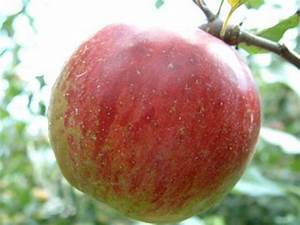
Before even moving to the farm, I started making our own apple cider vinegar (ACV). I am so glad that I took the time to learn this new skill. It was fortuitous that we moved to this property with about 50 apple trees AND these apples were planted to be used for ACV. I continue to make ACV and have decided to start making flavored vinegars to sell at the Farmers Market.
First, let me tell you how to make your own ACV. All you really need to start is some apples, ACV with the mother (Braggs is one variety of vinegar that has living mother in it), and sugar…
MAKING APPLE CIDER VINEGAR (ACV)
Fill a half gallon jar about half full of warm (NOT HOT) water. MUST BE UNCHLORINATED WATER. If you only have chlorinated water, boil it or let it sit for 24 hours so chlorine can dissipate.
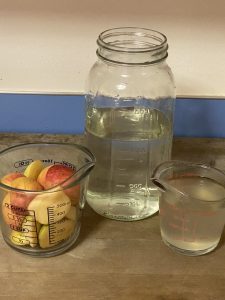
Add 1 cup of sugar and stir to dissolve.
Add 2 cups of chopped apple. You can also use scraps, like peelings, to make the vinegar. I would stick to using organic apples, if possible.
Add 1 cup of vinegar mother.
Fill the rest of the way up with warm water and then place a lid on so that NO PIECES OF APPLE ARE ABOVE THE WATER LINE. Do not use any metal or it may corrode. I like to put a small jar inside the mouth of the larger jar to push the apples down under the water.
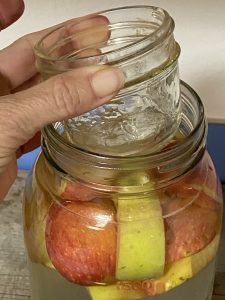
Cover with coffee filter and wrap towel around jar and set in an area that is about 70 degrees. This allows it to breath but keeps fruit flies out. Leave for 3-4 weeks.
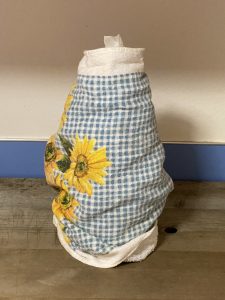
Strain off vinegar. Give apples to your chickens! Save 1 cup of the vinegar to start your next batch. You should have harvested about 1 ½ quarts of vinegar BUT IT’S NOT READY YET…
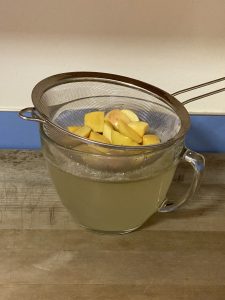
Pour freshly harvested vinegar into new jars and let sit another 4 weeks to age. Again, no metal lids (I know the jar in the middle has a metal lid but I was gifting it to someone and they were going to use it right away!). Now, it is ready to use!
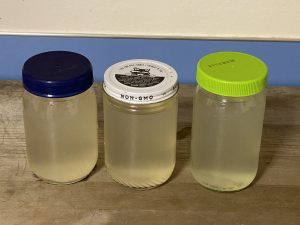
TIPS
* Keep your ACV ferment in a different place than other ferments in your home
* The longer you give the vinegar to ferment, the stronger the taste and tang will be. When the vinegar is to your liking, you can put it in the refrigerator to stop the fermenting.
* The length of the fermentation process will vary based on the temperature in your home. During summer, the ACV will take less time to ferment. In winter, it will likely take longer.
* If you see a gelatinous blob developing in the ACV, this is a “mother” and you can add it to your next ferment to get things going even faster. So do not be alarmed to see ‘webbed and murky’ stuff floating around in your homemade ACV. This is what holds all the nutrition and healing properties.
USES FOR ACV
* Drink it! ACV is a great probiotic. It may not taste the best, but it is generally considered safe to add 1 Tablespoon of ACV to a cup of water to drink. Beware…can erode tooth enamel…
- Elderberry, Pomegranate, and Apple Cider Vinegar Spritzer
By Rachel Johnson on cookinglight.com - 2 tablespoons apple cider vinegar
- 1 tablespoon elderberry syrup
- 1/3 cup pure pomegranate juice
- Sparkling water
- In a small sauce pot, bring vinegar, syrup, and pomegranate juice to a soft simmer.
- Serve divided between glasses. Serve warm or chilled, with a splash of sparkling water.
* Use ACV as a substitute for plain vinegar in any cooking recipe
* Use ACV instead of lemon juice in homemade mayonnaise
* Homemade Broth – add a tablespoon of ACV to your bones to help get the minerals out
* Make salad dressing:
2/3 cup olive oil
1/4 cup cider vinegar
1 tablespoon honey
2 teaspoons Dijon mustard
1 garlic cloves, minced
1/4 teaspoon salt
1/8 teaspoon pepper
Combine all ingredients in a jar with a tight-fitting lid; shake well. Store in the refrigerator. Just before serving, shake dressing again.
* Water Bath Canner or Steamer Juicer – I add a tablespoon of ACV to the water in my canner/juicer to keep the minerals from building up inside
* Fruit Fly Traps – I just pour some in a small dish and keep it near my composting container on my counter. I also add a couple drops of dish soap to the dish.
* Vinegar is an acid and is great for cleaning because it kills microorganisms
Homemade Natural Cleaning Products
Make your own all-purpose cleaner with one part water and one part ACV. Use it to clean hard surfaces in the kitchen and bathroom, including countertops, hard water stains, and drains.
Daily Shower Cleaner
1.5 cups water
1 cup vinegar
1/2 cup rubbing alcohol
1 teaspoon liquid dish soap (I like this kind– affiliate link)
15 drops lemon essential oil (these are my favorite essential oils ever)
15 drops melaleuca (tea tree) essential oil
Mix all the ingredients together in a quart-sized spray bottle.
Shake well, and spray onto shower surfaces every day after use.
Remember–this is designed as a maintenance spray, so I would suggest starting with a clean shower first. It won’t remove built-on grime by itself, it’ll just slow down the process.
Homemade Hair Rinses
After shampooing, just mix equal parts apple cider vinegar and water, massage into your hair, and rinse off. It helps remove buildup, it also works as a natural detangler and general scalp revitalizer. Best not to use this hair rinse if you have color treated hair.
Foot Soak
Mix equal parts apple cider vinegar and warm water with a tablespoon of Epsom salt. Soak your feet in the bath for 20 minutes. After soaking, rinse off feet and coat your feet in a hydrating cream, put on a pair of socks, and let the lotion sit on them overnight.
FLAVORED VINEGAR:
Add fruit to aged vinegar and let sit for 6 weeks. Strain and your flavored vinegar is complete!

